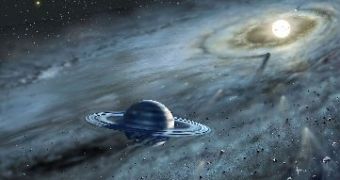While searching for supernova explosions that occurred in the early universe, in hope to probe dark energy, astronomers discovered two new objects in the solar system, one orbiting somewhere between Uranus and Neptune while the other lurking in the outer regions of the system. The search for supernova explosions mostly involves finding faint light sources, albeit sometimes objects in the solar system get in the way and are accidentally discovered.
Usually they are completely ignored by the vast majority of astronomers; however, Andrew Becker from the University of Washington believes that they're worth a much closer study. His finding reveal some new intriguing facts about the early history of the solar system. Out of the population of 14,000 asteroids orbiting in the inner solar system and 1,300 other new objects, Becker's undergraduate students filtered 14 unknown objects residing in the outer solar system.
One of those is 2003 UC414, an object 100 kilometers across, orbiting on a circular trajectory between Uranus and Neptune.
"You'd think something in between those two planets would be relatively unstable", Becker said, since two other objects found in that respective area appear to have unstable orbits. However, as it turns out, that of 2003 UC414 is relatively close to two zones of stability where objects could maintain a stable orbit for a couple of billions of years.
So far observations didn't establish whether or not the orbit of the object is stable, but if it is, then the theory that Uranus and Neptune swapped orbits sometime in the early history of the solar system could become obsolete, because such an event would have ejected any object orbiting between the two.
The second object that presents significant interest is a body measuring about 300 kilometers across, 2004 VN112, having an orbital plane tilted at 25 degrees in relation to that of the solar system and a highly elongated orbit that stretches between 1.5 to 30 times the distance between the Sun and Neptune. It appears to be gravitationally detached from the other planets in the solar system and could have been forced into such an orbit when the solar system lost a rogue planet, said Becker.
There are allegedly nine other known objects in the solar system which are gravitationally detached from the other planets, but how that might have happened remains unknown.

 14 DAY TRIAL //
14 DAY TRIAL //